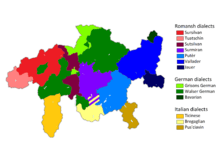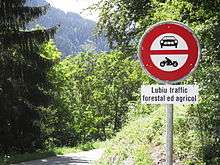Sursilvan dialects (Romansh)

Sursilvan (![]() [suʁsilˈvan] or romontsch sursilvan [ʁoˈmɔntʃ suʁsilˈvan]) is a group of dialects of the Romansh language spoken in the Swiss district of Surselva. It is the most widely spoken variety of Romansh with 17,897 people within the Surselva District (54.8%) naming Romansh as a habitually spoken language in the Swiss census of 2000.[1] The most closely related variety is Sutsilvan, which is spoken in the area located to the east of the district.
[suʁsilˈvan] or romontsch sursilvan [ʁoˈmɔntʃ suʁsilˈvan]) is a group of dialects of the Romansh language spoken in the Swiss district of Surselva. It is the most widely spoken variety of Romansh with 17,897 people within the Surselva District (54.8%) naming Romansh as a habitually spoken language in the Swiss census of 2000.[1] The most closely related variety is Sutsilvan, which is spoken in the area located to the east of the district.
The name of the dialect and the Surselva District is derived from sur 'above' and selva 'forest', with the forest in question being the Uaul Grond in the area affected by the Flims Rockslide. The word selva itself has fallen out of use in modern Sursilvan, with the most common word for forest being ![]() uaul , an Old High German loanword. Selva is only used for in a few more recent terms such as selvicultura 'forestry', selvicultur 'forest officer', or cavrer selvadi 'Long-eared owl'.
uaul , an Old High German loanword. Selva is only used for in a few more recent terms such as selvicultura 'forestry', selvicultur 'forest officer', or cavrer selvadi 'Long-eared owl'.

Distribution

Sursilvan is used across most of the Surselva District, with the exception of the Walser villages of Obersaxen, Vals, St. Martin and Safiental. Outside of the Surselva District, Flims is also part of the Sursilvan dialect area. In addition, Sursilvan was previously used as the written Romansh language of parts of the Sutsilvan dialect area. When a separate Sutsilvan written language was introduced in 1944, the villages of Bonaduz, Rhäzüns, Domat/Ems and Trin retained Sursilvan as their written language. In addition, Sursilvan was previously used in the Surmiran dialect area as the language of church, but has now been replaced by Standard Surmiran and Rumantsch Grischun.
Most municipalities in which Sursilvan is the traditional language still have a Romansh-speaking majority today. The exceptions are Flims, Laax, Schnaus, Ilanz, Castrisch, Surcuolm, and Duvin. In all of these, except for Flims, however, a majority of people reported in the 2000 Swiss census to use Romansh daily, even if only a minority named it as their language of best command. In about half of the Sursilvan villages, Romansh is the language of best command of over 70% or 80%. The highest percentage is found in Vrin with over 95%. As a daily language, it is used in nearly all municipalities by at least 70%, in about half by more than 80%, and in a third by over 90%. Overall across the Sursilvan dialect area, in the census of 2000, 70.1% named Romansh as a habitually used language, while 58.3% named it as their language of best command.[2]
Orthography
Sursilvan spelling mostly follows a phonemic system.
| Orthography | IPA | Example |
|---|---|---|
| а | [a] | |
| аi | [aɪ̯] | |
| аu | [aʊ̯] | |
| b | [b] | |
| c | in front of a, o, u as [k] in front of i and e as [ts] | |
| ch | [k] (only occurs in front of i and e) | |
| d | [d] | |
| e | [e] [ɛ] | |
| è | [ɛ] | |
| é | [e] | |
| ei | depending on the region as [ɛɪ̯] (Gruob), [aɪ̯] (Cadi) or [ɔɪ̯] (Breil/Brigels) | |
| eu | [ɛʊ̯] | |
| f | [f] | |
| g | as [g] in front ofi and e as [dʑ] (i is silent) | |
| gh | [g] (only occurs in front of i and e) | |
| gl | At the end of a word and in front of i as [ʎ] (i is silent) in front of a, u, o, e and some loanwords as [gl] | |
| gn | [ɲ] | |
| h | usually silent [h] in loanwords | |
| i | [i] | |
| ia | [ɪ̯a] | |
| ie | [ɪə̯] | |
| iu | [ɪʊ̯] | |
| iau | [ɪ̯aʊ̯] | |
| j | [j] | |
| l | [l] | |
| m | [m] | |
| n | [n] | |
| o | [ɔ] | |
| p | [p] | |
| r | generally a Uvular r | |
| s | [s] [z] in front of c, p, t, tg, n, m [ʃ] in front of g, b, d, v [ʒ] | |
| sch | [ʃ] [ʒ] | |
| t | [t] | |
| tsch | [tʃ] | |
| tg | [tɕ] | |
| u | [u] | |
| ua | [ʊ̯a] | |
| ue | [ʊ̯ɛ] | |
| uo | [ʊə̯] | |
| uei | [ʊ̯ɛɪ̯] | |
| uau | [ʊ̯aʊ̯] | |
| v | [v] | |
| z | [ts] | |
Literature
- Gereon Janzing, Rätoromanisch Wort für Wort, Reise Know-How Verlag Rump, 2006. ISBN 3-89416-365-8 (Deals in spite of its title only with Sursilvan).
- Alexi Decurtins, Niev vocabulari romontsch sursilvan - tudestg' / Neues rätoromanisches Wörterbuch surselvisch-deutsch, Chur 2001. ISBN 3-03900-999-0.
- Vieli/Decurtins, Vocabulari tudestg - romontsch sursilvan, Lia Rumantscha, 1994.
- Arnold Spescha, Grammatica sursilvana, Lehrmittelverlag Graubünden, Chur 1989. (This grammar is entirely written in Romansh.)
- Alexi Decurtins, Niev vocabulari romontsch sursilvan - tudestg' / Neues rätoromanisches Wörterbuch surselvisch-deutsch, Chur 2001. ISBN 3-03900-999-0.
- Vieli/Decurtins, Vocabulari tudestg - romontsch sursilvan, Lia Rumantscha, 1994.
- Arnold Spescha, Grammatica sursilvana, Lehrmittelverlag Graubünden, Chur 1989.
Sursilvan literature is published among others by the Lia Rumantscha in Chur.
Sample
The fable The Fox and the Crow by Jean de La Fontaine in Sursilvan, as well as a translation into English, the similar-looking but noticeably different-sounding dialect Sutsilvan, and Rumantsch Grischun.[3]
| Sursilvan |
Sutsilvan |
Rumantsch Grischun |
Translation |
|---|---|---|---|
| L'uolp era puspei inagada fomentada. Cheu ha ella viu sin in pegn in tgaper che teneva in toc caschiel en siu bec. Quei gustass a mi, ha ella tertgau, ed ha clamau al tgaper: «Tgei bi che ti eis! Sche tiu cant ei aschi bials sco tia cumparsa, lu eis ti il pli bi utschi da tuts». |
La gualp eara puspe egn'eada fumantada. Qua â ella vieu sen egn pegn egn corv ca taneva egn toc caschiel ainten sieus pecel. Quegl gustass a mei, â ella tartgieu, ed ha clamo agli corv: «Tge beal ca tei es! Scha tieus tgànt e aschi beal sco tia pareta, alura es tei igl ple beal utschi da tuts». |
La vulp era puspè ina giada fomentada. Qua ha ella vis sin in pign in corv che tegneva in toc chaschiel en ses pichel. Quai ma gustass, ha ella pensà, ed ha clamà al corv: «Tge bel che ti es! Sche tes chant è uschè bel sco tia parita, lur es ti il pli bel utschè da tuts». |
The fox was hungry yet again. There he saw a raven upon a fir holding a piece of cheese in its beak. This I would like, he thought, and shouted at the raven: "You are so beautiful! If your singing is as beautiful as your looks, then you are the most beautiful of all birds.". |
References
- ↑ Gross (2004). p. 31
- ↑ Cathomas (2008). pp. 19
- ↑ Gross, Manfred (2004), Rumantsch – Facts & Figures. (PDF) . Retrieved on 2012-02-28. Archived April 18, 2012, at the Wayback Machine.